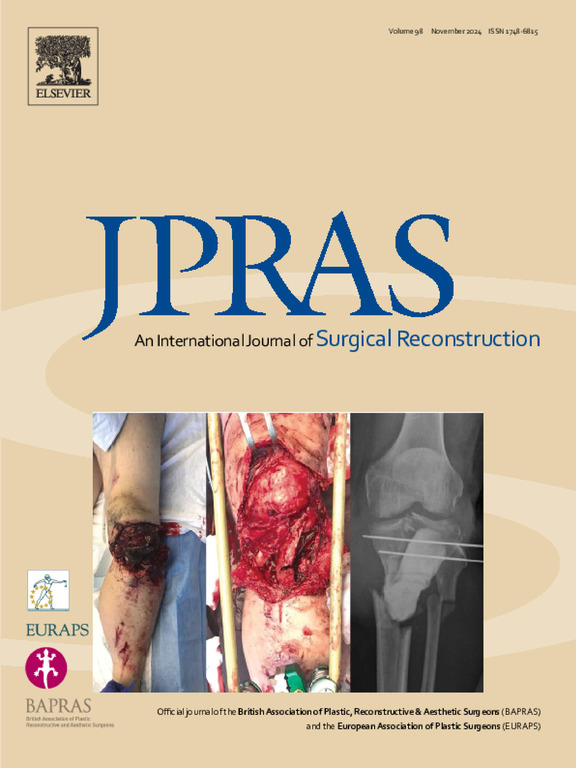Divergent effects of vitamin D3 on human dermal fibroblasts and keratinocytes in wound repair: Implications for therapeutic targeting in tissue remodelling and scarring
IF 2.4
3区 医学
Q2 SURGERY
Journal of Plastic Reconstructive and Aesthetic Surgery
Pub Date : 2025-04-17
DOI:10.1016/j.bjps.2025.04.019
引用次数: 0
Abstract
Background
Vitamin D is known to regulate inflammation and immunity, suggesting it may play a role in wound healing. However, its mechanism of action in key skin cell types—keratinocytes and fibroblasts—involved in wound repair is poorly understood.
Objectives
This study aimed to elucidate the impact of vitamin D3 and its precursors on keratinocyte and fibroblast behaviour during wound healing using human ex vivo skin explant and primary cell culture models.
Methods
The rate of closure of incisional wounds made on human ex vivo skin explants treated with the vitamin D3 precursor, cholecalciferol, or the active form 1,25(OH)2D3 was measured over 6 days in culture. Primary cultures of human keratinocytes and dermal fibroblasts were propagated from female facial skin, and changes in gene expression and physiological responses to cholecalciferol or 1,25(OH)2D3 were assessed using various techniques, including scratch wound assays, quantitative reverse transcription polymerase chain reaction, zymography, and immunocytochemistry.
Results
1,25(OH)2D3 significantly increased the early wound closure rate in ex vivo human skin explants, while cholecalciferol had no effect. 1,25(OH)2D3 accelerated keratinocyte migration but inhibited fibroblast migration and their transition into pro-fibrotic myofibroblasts, reducing extracellular matrix remodelling. Using small interfering RNA, it was established that responses were mediated by vitamin D receptor signalling.
Conclusions
This study highlighted the divergent effects of vitamin D on keratinocyte and fibroblast wound responses, i.e., promoting re-epithelialisation, while potentially suppressing aberrant fibrosis. Optimising vitamin D status may facilitate wound repair while minimising scarring, which has implications for treating non-healing wounds and excessive scarring disorders.

维生素D3对人皮肤成纤维细胞和角化细胞在伤口修复中的不同作用:组织重塑和瘢痕形成治疗靶向的意义
众所周知,维生素D可以调节炎症和免疫,这表明它可能在伤口愈合中发挥作用。然而,其在关键皮肤细胞类型——角质形成细胞和成纤维细胞中参与伤口修复的作用机制尚不清楚。目的通过体外皮肤移植和原代细胞培养模型,研究维生素D3及其前体对创面愈合过程中角质形成细胞和成纤维细胞行为的影响。方法用维生素D3前体、胆钙化醇或活性形式1,25(OH)2D3分别处理体外人皮肤外植体,观察其6 d的伤口愈合率。以女性面部皮肤为材料,培养人角质形成细胞和真皮成纤维细胞,采用抓伤法、定量逆转录聚合酶链反应、酶谱法和免疫细胞化学等多种技术,观察1,25(OH)2D3和胆骨化醇的基因表达变化和生理反应。结果1,25(OH)2D3显著提高体外人皮肤早期创面愈合率。而胆骨化醇则没有效果。1,25(OH)2D3加速了角质形成细胞的迁移,但抑制了成纤维细胞的迁移及其向前纤维化肌成纤维细胞的转变,减少了细胞外基质的重塑。利用小干扰RNA,确定了反应是由维生素D受体信号介导的。本研究强调了维生素D对角化细胞和成纤维细胞伤口反应的不同作用,即促进再上皮化,同时潜在地抑制异常纤维化。优化维生素D状态可以促进伤口修复,同时最大限度地减少疤痕,这对治疗不愈合的伤口和过度疤痕障碍具有重要意义。
本文章由计算机程序翻译,如有差异,请以英文原文为准。
求助全文
约1分钟内获得全文
求助全文
来源期刊
CiteScore
3.10
自引率
11.10%
发文量
578
审稿时长
3.5 months
期刊介绍:
JPRAS An International Journal of Surgical Reconstruction is one of the world''s leading international journals, covering all the reconstructive and aesthetic aspects of plastic surgery.
The journal presents the latest surgical procedures with audit and outcome studies of new and established techniques in plastic surgery including: cleft lip and palate and other heads and neck surgery, hand surgery, lower limb trauma, burns, skin cancer, breast surgery and aesthetic surgery.

 求助内容:
求助内容: 应助结果提醒方式:
应助结果提醒方式:


